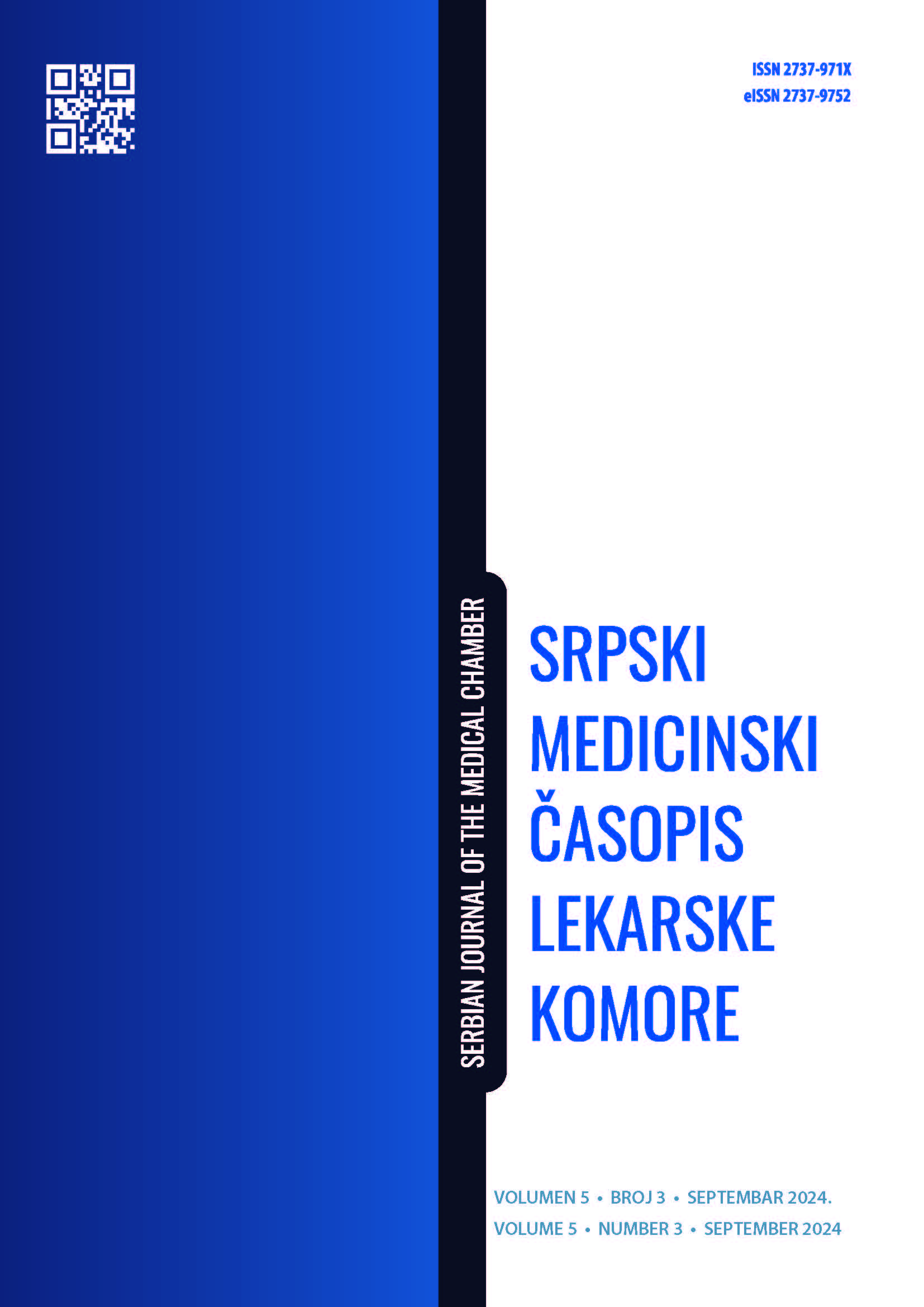CLINICAL MANIFESTATIONS ASSOCIATED WITH THE PRESENCE OF ANTIPHOSPHOLIPID ANTIBODIES
Manifestations of antiphospholipid antibodies
Abstract
Antiphospholipid antibodies (aPL antibodies) are a heterogeneous group of autoantibodies that target anionic phospholipids or phospholipid-binding proteins. They can be associated with numerous clinical manifestations in almost all areas of clinical medicine, but antiphospholipid syndrome (APS) is the most precisely defined entity. The most common clinical manifestations of aPL are thrombosis in any part of the circulation, as well as pregnancy complications in the form of miscarriage or premature birth due to preeclampsia, eclampsia, or placental insufficiency. According to the modified Sapporo classification of 2006, thrombosis and/or pregnancy complications represent the clinical criteria for diagnosing APS. However, in approximately a quarter of patients with APS, additional clinical manifestations are present, which are not accepted as criteria for APS. Interestingly, these manifestations can be associated with aPL antibodies even in the absence of thrombosis or pregnancy morbidity, i.e., without the presence of the criteria for definitive APS. Recognizing non-criteria manifestations is highly significant because it can draw attention to the possible presence of aPL antibodies and indicate the presence of APS or the risk of its occurrence. The latest classification was published in 2023 by the American College of Rheumatology/European Alliance of Rheumatology Associations (ACR/EULAR). It expanded the list of clinical criteria for the recognition of antiphospholipid syndrome. This classification demonstrates higher specificity but lesser sensitivity in recognizing APS than earlier criteria. At present, the application of the ACR/EULAR criteria is primarily intended for research purposes, i.e., selecting study subjects, rather than for diagnosing APS in everyday clinical practice.
References
Levine JS, Branch DW, Rauch J. The antiphospholipid syndrome. N Engl J Med. 2002 Mar 7;346(10):752-63. doi: 10.1056/NEJMra002974.
Svenungsson E, Antovic A. The antiphospholipid syndrome - often overlooked cause of vascular occlusions? J Intern Med. 2020 Apr;287(4):349-72. doi: 10.1111/joim.13022.
Devreese K, Hoylaerts MF. Laboratory diagnosis of the antiphospholipid syndrome: a plethora of obstacles to overcome. Eur J Haematol. 2009 Jul;83(1):1-16. doi: 10.1111/j.1600-0609.2009.01243.x.
Uthman IW, Gharavi AE. Viral infections and antiphospholipid antibodies. Semin Arthritis Rheum. 2002 Feb;31(4):256-63. doi: 10.1053/sarh.2002.28303.
Miyakis S, Lockshin MD, Atsumi T, Branch DW, Brey RL, Cervera R, et al. International consensus statement on an update of the classification criteria for definite antiphospholipid syndrome (APS). J Thromb Haemost. 2006 Feb;4(2):295-306. doi: 10.1111/j.1538-7836.2006.01753.x.
Devreese K, Hoylaerts MF. Challenges in the diagnosis of the antiphospholipid syndrome. Clin Chem. 2010 Jun;56(6):930-40. doi: 10.1373/clinchem.2009.133678.
Pengo V, Ruffatti A, Legnani C, Testa S, Fierro T, Marongiu F, et al. Incidence of a first thromboembolic event in asymptomatic carriers of high-risk antiphospholipid antibody profile: a multicenter prospective study. Blood. 2011 Oct 27;118(17):4714-8. doi: 10.1182/blood-2011-03-340232.
Pengo V, Ruffatti A, Tonello M, Cuffaro S, Banzato A, Bison E, et al. Antiphospholipid syndrome: antibodies to Domain 1 of β2-glycoprotein 1 correctly classify patients at risk. J Thromb Haemost. 2015 May;13(5):782-7. doi: 10.1111/jth.12865.
Petri M. Epidemiology of the antiphospholipid antibody syndrome. J Autoimmun. 2000 Sep;15(2):145-51. doi: 10.1006/jaut.2000.0409.
Meroni PL, Mari D, Monti D, Coppola R, Capri M, Salvioli S, et al. Anti-beta 2 glycoprotein I antibodies in centenarians. Exp Gerontol. 2004 Oct;39(10):1459-65. doi: 10.1016/j.exger.2004.08.003.
Wilson WA, Gharavi AE, Koike T, Lockshin MD, Branch DW, Piette JC, et al. International consensus statement on preliminary classification criteria for definite antiphospholipid syndrome: report of an international workshop. Arthritis Rheum. 1999 Jul;42(7):1309-11. doi: 10.1002/1529-0131(199907)42:7<1309::AID-ANR1>3.0.CO;2-F.
Barbhaiya M, Zuily S, Naden R, Hendry A, Manneville F, Amigo MC, et al.; ACR/EULAR APS Classification Criteria Collaborators. The 2023 ACR/EULAR Antiphospholipid Syndrome Classification Criteria. Arthritis Rheumatol. 2023 Oct;75(10):1687-702. doi: 10.1002/art.42624.
Andreoli L, Chighizola CB, Banzato A, Pons-Estel GJ, Ramire de Jesus G, Erkan D. Estimated frequency of antiphospholipid antibodies in patients with pregnancy morbidity, stroke, myocardial infarction, and deep vein thrombosis: a critical review of the literature. Arthritis Care Res (Hoboken). 2013 Nov;65(11):1869-73. doi: 10.1002/acr.22066.
Schulman S, Svenungsson E, Granqvist S. Anticardiolipin antibodies predict early recurrence of thromboembolism and death among patients with venous thromboembolism following anticoagulant therapy. Duration of Anticoagulation Study Group. Am J Med. 1998 Apr;104(4):332-8. doi: 10.1016/s0002-9343(98)00060-6.
Cervera R, Piette JC, Font J, Khamashta MA, Shoenfeld Y, Camps MT, et al.; Euro-Phospholipid Project Group. Antiphospholipid syndrome: clinical and immunologic manifestations and patterns of disease expression in a cohort of 1,000 patients. Arthritis Rheum. 2002 Apr;46(4):1019-27. doi: 10.1002/art.10187.
Cervera R, Piette JC, Font J, Khamashta MA, Shoenfeld Y, Camps MT, et al.; Euro-Phospholipid Project Group. Antiphospholipid syndrome: clinical and immunologic manifestations and patterns of disease expression in a cohort of 1,000 patients. Arthritis Rheum. 2002 Apr;46(4):1019-27. doi: 10.1002/art.10187.
Grosso G, Sippl N, Kjellström B, Amara K, de Faire U, Elvin K, et al. Antiphospholipid Antibodies in Patients With Myocardial Infarction. Ann Intern Med. 2019 Feb 19;170(4):277-80. doi: 10.7326/M18-2130.
Pastori D, Bucci T, Triggiani M, Ames PRJ, Parrotto S, Violi F, et al. Immunoglobulin G (IgG) anticardiolipin antibodies and recurrent cardiovascular events. A systematic review and Bayesian meta-regression analysis. Autoimmun Rev. 2019 May;18(5):519-25. doi: 10.1016/j.autrev.2019.03.005.
Di Simone N, Luigi MP, Marco D, Fiorella DN, Silvia D, Clara DM, et al. Pregnancies complicated with antiphospholipid syndrome: the pathogenic mechanism of antiphospholipid antibodies: a review of the literature. Ann N Y Acad Sci. 2007 Jun;1108:505-14. doi: 10.1196/annals.1422.054.
Sevim E, Zisa D, Andrade D, Sciascia S, Pengo V, Tektonidou MG, et al.; APS ACTION Investigators. Characteristics of Patients With Antiphospholipid Antibody Positivity in the APS ACTION International Clinical Database and Repository. Arthritis Care Res (Hoboken). 2022 Feb;74(2):324-35. doi: 10.1002/acr.24468.
Samanta D, Cobb S, Arya K. Sneddon Syndrome: A Comprehensive Overview. J Stroke Cerebrovasc Dis. 2019 Aug;28(8):2098-108. doi: 10.1016/j.jstrokecerebrovasdis.2019.05.013.
Bienaimé F, Legendre C, Terzi F, Canaud G. Antiphospholipid syndrome and kidney disease. Kidney Int. 2017 Jan;91(1):34-44. doi: 10.1016/j.kint.2016.06.026.
Cervera R, Bucciarelli S, Plasín MA, Gómez-Puerta JA, Plaza J, Pons-Estel G, et al.; Catastrophic Antiphospholipid Syndrome (CAPS) Registry Project Group (European Forum On Antiphospholipid Antibodies). Catastrophic antiphospholipid syndrome (CAPS): descriptive analysis of a series of 280 patients from the "CAPS Registry". J Autoimmun. 2009 May-Jun;32(3-4):240-5. doi: 10.1016/j.jaut.2009.02.008.

